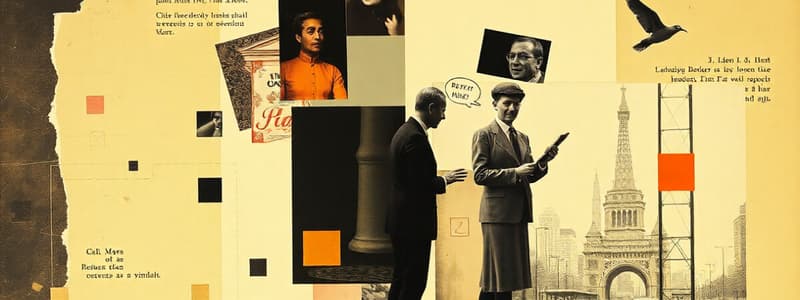Podcast
Questions and Answers
Which model emphasizes one-way communication intended to inform the public without seeking feedback?
Which model emphasizes one-way communication intended to inform the public without seeking feedback?
- Public Information Model (correct)
- Two-Way Symmetrical Communication
- Press Agentry/Publicity
- Two-Way Asymmetrical Communication
What is a key characteristic of Two-Way Asymmetrical Communication?
What is a key characteristic of Two-Way Asymmetrical Communication?
- It is primarily focused on developing mutual understanding.
- It involves equal participation from both parties.
- It seeks to manipulate public opinion. (correct)
- It emphasizes transparency and accountability.
Which motivation for public relations is primarily concerned with gaining public support and demonstrating credibility?
Which motivation for public relations is primarily concerned with gaining public support and demonstrating credibility?
- Profit
- Legitimacy (correct)
- Advocacy
- Agitation
Which model is characterized by mutual understanding and relationship building between the organization and the public?
Which model is characterized by mutual understanding and relationship building between the organization and the public?
What is an example of a motivation for public relations that focuses on influencing social change?
What is an example of a motivation for public relations that focuses on influencing social change?
Which motivation for public relations is focused on contributing to the profit goals of an organization?
Which motivation for public relations is focused on contributing to the profit goals of an organization?
What is the primary focus of the Public Information Model in public relations?
What is the primary focus of the Public Information Model in public relations?
Which communication model primarily emphasizes the organization's interests over the public's feedback?
Which communication model primarily emphasizes the organization's interests over the public's feedback?
In which motivation for public relations is the aim to sway public opinion and encourage action?
In which motivation for public relations is the aim to sway public opinion and encourage action?
Which element is NOT typically associated with Two-Way Symmetrical Communication?
Which element is NOT typically associated with Two-Way Symmetrical Communication?
What is the primary characteristic of the Press Agentry/Publicity model?
What is the primary characteristic of the Press Agentry/Publicity model?
Which motivation for public relations is mainly aimed at creating a positive image and enhancing legitimacy?
Which motivation for public relations is mainly aimed at creating a positive image and enhancing legitimacy?
In a Two-Way Asymmetrical Communication model, the primary focus is on what?
In a Two-Way Asymmetrical Communication model, the primary focus is on what?
Which of the following models includes a goal of mutual understanding and compromise?
Which of the following models includes a goal of mutual understanding and compromise?
What is a key goal of the Agitation motivation in public relations?
What is a key goal of the Agitation motivation in public relations?
Flashcards are hidden until you start studying
Study Notes
Grunig and Hunt's Four Models
- Press Agentry/Publicity: Focuses on gaining media attention, regardless of accuracy.
- Public Information: Emphasizes disseminating accurate information to the public.
- Two-Way Asymmetrical Communication: Uses research to persuade publics to accept the organization's viewpoint.
- Two-Way Symmetrical Communication: Focuses on mutual understanding between the organization and its publics.
Press Agentry/Publicity in History
- Often used in the early days of public relations.
- Emphasis on sensationalism and attention-grabbing tactics.
- Often associated with PT Barnum and his famous circus.
Modern Use of Press Agentry/Publicity
- Still used in some cases, particularly in entertainment and crisis communication.
- Can be effective in generating buzz and short-term results.
Public Information Model
- Emphasizes objectivity and accuracy in communication.
- Used by government agencies, non-profit organizations, and educational institutions.
- Focuses on providing information to the public in a clear and concise way.
Two-Way Asymmetrical Communication
- Uses research to target specific publics and tailor messages to their interests.
- Emphasizes persuasion and advocacy.
- Often used by corporations and political campaigns.
Two-Way Symmetrical Communication
- Emphasizes dialogue and mutual understanding between the organization and its publics.
- Uses research to understand the needs and concerns of publics.
- Aims to build long-term relationships based on trust and transparency.
Motivations for PR -- Recruitment
- Organizations use PR to attract and retain talent.
- This can involve promoting the organization's culture, values, and benefits.
Motivations for PR -- Legitimacy
- Organizations use PR to enhance their reputation and gain public acceptance.
- This can involve highlighting their positive contributions to society and addressing negative perceptions.
Motivations for PR -- Agitation
- Used to advocate for social change and raise awareness of important issues.
- Often used by activist groups and non-profit organizations.
- Emphasizes mobilizing support for a cause.
Motivations for PR -- Advocacy
- Used to promote a particular viewpoint or position on an issue.
- Often used by political groups, lobbyists, and advocacy organizations.
- Goal is to influence public opinion and policy decisions.
Motivations for PR -- Profit
- Organizations use PR to increase sales revenue and profits.
- This can involve building brand awareness, generating leads, and promoting products and services.
Grunig and Hunt's Four Models
- The four models are Press Agentry/Publicity, Public Information, Two-Way Asymmetrical Communication, and Two-Way Symmetrical Communication
- Models explain the relationship between public relations practitioners and their publics
- Models help to understand different approaches to public relations and their effectiveness
Press Agentry/Publicity in History
- Focuses on getting publicity for the client
- Developed in the 1800s
- P.T Barnum is one of the key figures
Modern Use of Press Agentry/Publicity
- Used by celebrities, entertainers, and some businesses
- Emphasizes attention-getting, even if it's negative
- Uses techniques like stunts, media attention, and exaggeration
Public Information Model
- Developed in the early 1900s
- Objective is to disseminate information
- Focuses on providing accurate information to the public
- Uses press releases, public service announcements, and other forms of communication
- Employed by government agencies and non-profit organizations
Two-Way Asymmetrical Communication
- Emphasizes persuasion
- Uses research to understand the target audience and persuade them
- Less emphasis on listening to the audience
- More about influencing and shaping public opinion
Two-Way Symmetrical Communication
- Focuses on mutual understanding and dialogue
- Uses research to understand the needs and concerns of the public
- Employs communication to build relationships with the public
- Used by companies and organizations that seek to build trust and good relationships with their stakeholders
Motivations for PR -- Recruitment
- Public relations can be used to recruit new workers
Motivations for PR -- Legitimacy
- Public relations helps organizations gain legitimacy
- Establishing credibility among stakeholders is crucial
Motivations for PR -- Agitation
- Organizations can use PR to promote causes or make social changes
- Often used by social movements and activist groups
Motivations for PR -- Advocacy
- Individuals can use PR to champion causes
- Advocacy groups use PR to persuade others
- Often involves lobbying, communication with media, and social media
Motivations for PR -- Profit
- Businesses use public relations to increase profitability
- Key strategies involve promoting products, services, and positive brand image
Grunig and Hunt's Four Models
- Grunig and Hunt developed a four-model framework for understanding public relations
- The models describe different levels of communication and the relationship between organizations and publics
- Each model is distinguished by: the goals of communication, the nature of the relationship between the organization and its publics, and the communication methods used
Press Agentry/Publicity in History
- Early form of public relations that uses attention-grabbing tactics to generate publicity and promote an organization or individual
- Often relies on sensationalism and self-promotion
- P.T. Barnum was a pioneer of this model
Modern Use of Press Agentry/Publicity
- Still used today by some organizations, especially in entertainment and marketing
- Often seen as manipulative and unethical, but can be effective in generating short-term attention
Public Information Model
- Focuses on disseminating information from an organization to its publics, often through the media
- Aims to build relationships based on trust and transparency
- The public information model is often used by governments and non-profit organizations
Two-Way Asymmetrical Communication
- Involves conducting research to understand the attitudes and opinions of publics to tailor messages for maximum effect
- Focuses on persuading publics to accept the organization’s point of view
- Persuasive communication is essential in this model
Two-Way Symmetrical Communication
- Seeks to build genuine dialogue and understanding between organizations and their publics
- Aims to resolve conflicts and build lasting relationships
- This model emphasizes negotiation and compromise
Motivations for PR -- Recruitment
- Organizations use PR to attract and retain employees
- Public relations activities can help shape an organization’s image as a desirable employer
Motivations for PR -- Legitimacy
- PR helps organizations to gain acceptance and credibility from stakeholders
- Legitimacy is crucial for gaining support, resources, and trust
Motivations for PR -- Agitation
- Organizations and individuals use public relations to influence public opinion and policy
- Often used by advocacy groups and activists
- Public relations activities can raise awareness, mobilize support, and put pressure on decision-makers
Motivations for PR -- Advocacy
- Public relations can be used to champion a cause, idea, or policy
- Can involve promoting a specific position
Motivations for PR -- Profit
- Organizations use public relations to increase sales revenue and profitability
- Public relations activities can build brand awareness, generate leads, and drive customer engagement
Motivations for PR -- Social Responsibility
- Organizations engage in public relations to demonstrate their commitment to ethical practices and social good
- It promotes positive relationships with publics
- Activities often focus on sustainability, social justice, and community outreach
Studying That Suits You
Use AI to generate personalized quizzes and flashcards to suit your learning preferences.




